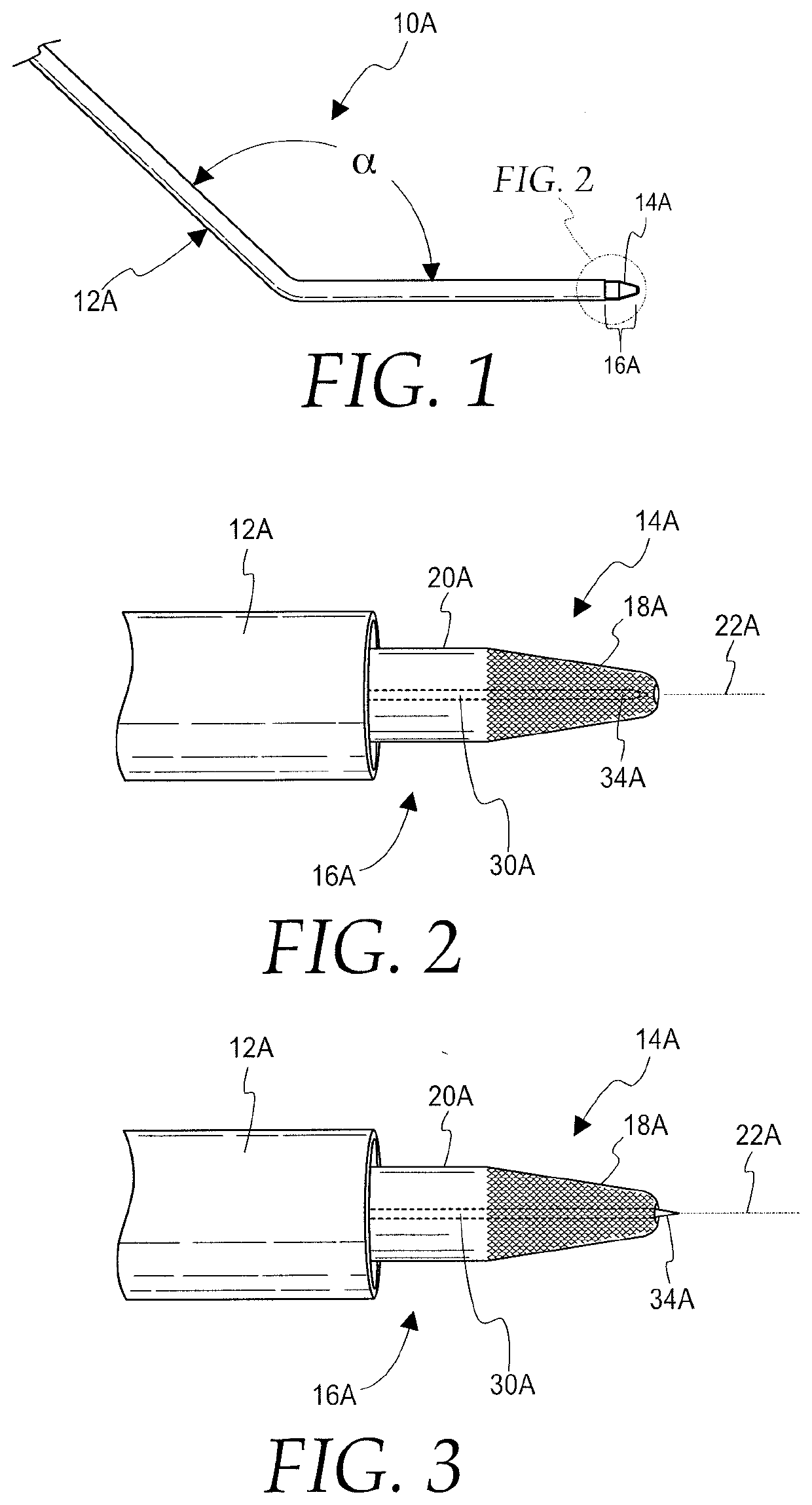Surgical instrument and method for goniotomy procedure
a surgical instrument and goniotomy technology, applied in the field of surgical instruments, can solve the problems of damage to the internal structure of the eye, the size of the eye, and the eye cannot return to normal, and achieve the effect of improving visibility
- Summary
- Abstract
- Description
- Claims
- Application Information
AI Technical Summary
Benefits of technology
Problems solved by technology
Method used
Image
Examples
first embodiment
[0054]a goniotomy surgical instrument of the present invention is illustrated in FIGS. 1-3, wherein the instrument is designated generally by the reference number 10A. The first illustrated embodiment of the instrument 10A includes an elongated hand grip portion 12A for being gripped by a user of the instrument 10A, and which can be provided with either a rounded configuration as illustrated or with a flattened, polygonal, or irregular configuration (not illustrated). The hand grip portion 12A has a proximal end and a distal end.
[0055]Referring to FIG. 1, the hand grip portion 12A proximal and distal sections or portions are arranged at an obtuse angle (α) relative to each other of between about 120 degrees and about 140 degrees, and more preferably at an angle (α) of about 130 degrees.
[0056]The instrument 10A includes a specifically configured scraping or abrading tip portion 14A, extending from the distal end of the hand grip portion 12A, which facilitates scraping, rubbing, massa...
seventh embodiment
[0102]The ninth illustrated embodiment of the instrument 10I differs from the prior discussed seventh embodiment of the invention in that the instrument 10I includes a relatively smooth, non-abrasive surface 50I on the distal or free end 18I of the tip portion 14I and an opposite, first abrasive surface 60I. The first abrasive surface 60I is concave and faces downward or on the bottom of the tip portion 14I. The smooth surface 60I connects to the proximal portion 20I of the elastomeric element 16I, and it is also concave and faces upward or on top of the tip portion 14I. The distalmost portion of the free end 18I has a rounded, blunted symmetrical shape and is preferably smoothed to the same extent as the surface 60I. The roughness of the surface 60I may be formed by sandblasting, glass-bead blasting, or other blasting of the elastomeric element 16I or formed by impregnation of a grit-like substance (diamond dust, particulates within the elastomeric element 16I etc.).
[0103]As can be...
second embodiment
[0105]The tenth illustrated embodiment of the instrument 10J differs from the prior discussed second embodiment of the invention in that the instrument 10J includes an elastomeric element 16J and tip portion 14J having the form of a pyramidal frustum that tapers along the central geometric axis 22J (FIG. 23 only). The elastomeric element 16J is affixed to the instrument handle portion 12J by a generally uniform cross-sectional shape base portion 20J and terminates in a rectangular or square blunted, free end 18J. The pyramidal frustum includes relatively smooth, non-abrasive top and opposite, bottom sides or surfaces 40J (top surface being visible in FIGS. 21 and 23) and a relatively abrasive, opposite lateral surfaces 60J (right side surface visible in FIGS. 21 and 22). The distalmost portion of the free end 18J is preferable roughened to the same extent as the surface 60J. The roughness of the surfaces 60J and 18J may be formed by sandblasting, glass-bead blasting, or other blasti...
PUM
 Login to View More
Login to View More Abstract
Description
Claims
Application Information
 Login to View More
Login to View More - R&D Engineer
- R&D Manager
- IP Professional
- Industry Leading Data Capabilities
- Powerful AI technology
- Patent DNA Extraction
Browse by: Latest US Patents, China's latest patents, Technical Efficacy Thesaurus, Application Domain, Technology Topic, Popular Technical Reports.
© 2024 PatSnap. All rights reserved.Legal|Privacy policy|Modern Slavery Act Transparency Statement|Sitemap|About US| Contact US: help@patsnap.com










